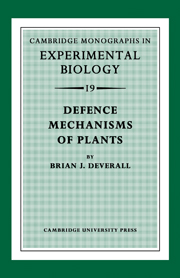Book contents
- Frontmatter
- Contents
- Preface
- 1 INTRODUCTION TO THE HOST–PARASITE INTERACTION
- 2 DISCRIMINATORY EVENTS BEFORE AND DURING PENETRATION INTO PLANTS
- 3 CYTOLOGICAL CHANGES IN HOST AND PARASITE AFTER INFECTION
- 4 CROSS-PROTECTION AND INDUCED RESISTANCE
- 5 PHYTOALEXINS AND THEIR INDUCED FORMATION AND BIOSYNTHESIS
- 6 ROLE OF PHYTOALEXINS IN DEFENCE MECHANISMS
- 7 MEDIATION OF HOST–PARASITE SPECIFICITY
- References
- Index
7 - MEDIATION OF HOST–PARASITE SPECIFICITY
Published online by Cambridge University Press: 10 May 2010
- Frontmatter
- Contents
- Preface
- 1 INTRODUCTION TO THE HOST–PARASITE INTERACTION
- 2 DISCRIMINATORY EVENTS BEFORE AND DURING PENETRATION INTO PLANTS
- 3 CYTOLOGICAL CHANGES IN HOST AND PARASITE AFTER INFECTION
- 4 CROSS-PROTECTION AND INDUCED RESISTANCE
- 5 PHYTOALEXINS AND THEIR INDUCED FORMATION AND BIOSYNTHESIS
- 6 ROLE OF PHYTOALEXINS IN DEFENCE MECHANISMS
- 7 MEDIATION OF HOST–PARASITE SPECIFICITY
- References
- Index
Summary
Parasitic fungi and bacteria require general attributes to fit themselves for the parasitic, rather than the saprophytic, habit, and possess special features which enable them to be virulent on particular taxonomic groupings of host plants. The general properties of parasites include the ability to enter a plant by a specialized route, the capacity to synthesize enzymes for breaching barriers presented by cuticles and cell walls, the ability to obtain nutrients from the host, possibly via haustoria, and perhaps, the capacity to tolerate or to metabolize anti-microbial compounds in the host plant. Fine degrees of specialization might sometimes depend upon success or failure of these processes, but it should be clear from Chapters 1, 2 and 3 that the fate of parasitism is usually dependent upon the matching of very specific information, determined by complementary genes in host and parasite and expressed after penetration into host cells. The major question for this chapter concerns the intermolecular means by which the single genes in host and parasite express themselves. In what form is the information based on the DNA in both partners compared?
It seems logical that expression of specificity is mediated by nucleic acids, peptides and proteins, although lipoproteins, polysaccharides, glycoproteins and glycolipids may also be able to act as mediation factors. The essential feature of these molecules is that they are made up of many subunits arranged in particular sequences and thus suited to recognize matching molecules in the other partner in the host–parasite relationship.
- Type
- Chapter
- Information
- Defence Mechanisms of Plants , pp. 75 - 88Publisher: Cambridge University PressPrint publication year: 1977
- 1
- Cited by



